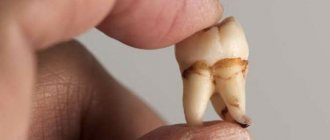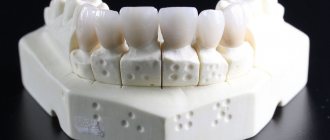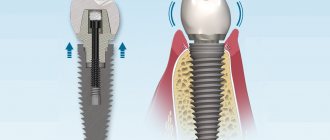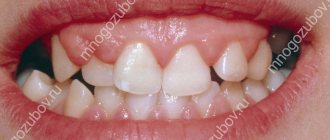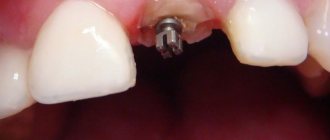Restoring a damaged tooth using a pin is a popular dental technique. A metal rod is fixed in the root canal, after which a filling or artificial crown is installed.
In order for the restored tooth to last longer, it is important to strictly follow the dentist’s recommendations, monitor oral hygiene, and limit the consumption of very hard foods. In some cases, complications may occur after restoration. One of them is loosening of the dental unit. Find out what causes it and how to solve the problem.
Do you need a pin for a crown?
If the doctor insists on prosthetics, this already means that the tooth has undergone significant destruction. The crown helps restore the chewing function of the damaged unit and the aesthetics of the smile, this is especially true for the frontal region. Obviously, the prosthesis must have the necessary support. If there is a sufficient amount of natural tissue, the crown is placed directly on the tooth. In other cases, pins and stump inlays come to the rescue.
- Tooth decay of more than 30% is a good reason for installing a pin and crown.
- A chip of one of the walls of a tooth by 50% or more or a fracture at the root are indications for installing a core inlay and crown.
The technology also has limitations. A pin cannot be placed if there is untreated pulpitis, periodontitis and their complications (cyst, gumboil, etc.). Treatment will have to be abandoned if there are abnormalities in the structure of the tooth roots (too much curvature or thin walls). In some situations, the doctor is unable to unfill the canals after previous endodontic treatment, which also affects the possibility of installing a pin.
Options for solving problems in dentistry
The first option: the doctor returns the fallen product to its place using glue. Before this, the remains of old cement are removed from the structure, and the stump is treated with an antiseptic. In the case of an implant with a screw type of fastening, the prosthesis is re-fixed in place.
The second option: the specialist prepares the tooth for the creation of a new crown. This must be done if there was inflammation under the structure that needed to be treated (accordingly, the stump will then decrease in size and acquire new parameters). Or if the old structure cannot be thoroughly cleaned of glue, it is damaged or its service life has expired.
The third option: tooth extraction, preparation for subsequent implantation or bridge prosthetics. This is an extreme measure when the hard tissues and root are destroyed and cannot be restored.
Inlay or pin: which is better?
The choice of support element depends on the specific clinical case. Both the pin and the core tab perform similar functions. However, each solution has its own advantages and disadvantages.
| Crowns on pins | Crowns on core inlays |
|
|
The stump tab is considered a more reliable option for chewing teeth and if it is necessary to install bridges. It is important to understand that this significantly increases the cost of treatment (the price per tab can reach up to 10,000 rubles). In addition, the manufacture of a stump insert requires an additional laboratory stage and appropriate manipulations.
Placing a crown on a pin can be recommended if the tooth does not have serious damage and there is no risk of pin breakage and root canal injury under the influence of chewing load. However, not all pins are suitable for the restoration of anterior teeth, especially if metal-free crowns are used. The crown and post on the front tooth should not contain metal if you want good aesthetics.
When installing a ceramic crown on a front tooth, the core inlay should also be made of ceramic.
What symptoms should you consult a doctor for?
Risks can be identified during the recovery period after surgery. This:
- Pain that only gets worse, but 10 or more days have passed since the operation.
- Swelling that does not go away after 7 days.
- The bleeding does not stop a day or two after the intervention.
- There is pus and a strange smell.
- The temperature stays above 38o.
But it happens that dental implants (usually titanium) were installed relatively long ago, and the healing process is behind them. There seem to be no tangible problems, but the structure becomes unstable. During the examination, fistula tracts, perforations, and other problems may be detected.
Filling on a pin or crown: which is better?
This question interests many patients, and the answer is obvious. From the point of view of strength and reliability, the best option would be to install a pin and a crown. It is better to place a pin in a tooth under a crown in cases where the tooth is significantly damaged, especially when it comes to molars. A pin with a filling is installed for less significant damage and most often on the front teeth. This method also has its advantages. Firstly, this is a much cheaper technique. Secondly, all treatment takes place in one visit. The patient quickly returns to normal life and forgets about his problem. However, a filling with a pin gives a less reliable and predictable result.
In what cases are there chances to return the prosthesis to its place?
It must be emphasized that in most clinical cases, crowns fall out in such a way that they are then quite difficult to put back. Initially, they are “set” on a large amount of cement, which is almost impossible to remove thoroughly. After re-installation, the old structure will no longer fit tightly, it will not be able to exactly replicate the anatomy of the tooth, and food debris will begin to clog inside, which can cause inflammation. However, a fallen prosthesis can be returned to its place, and the likelihood of a favorable outcome will be higher in the following situations:
- if the crown has fallen out, and underneath there is a healthy tooth (stump), not affected by caries and other dental diseases,
- if the prosthesis is completely intact and relatively new (its service life has not expired): there are no chips, breaks or damage on it,
- if a temporary restoration falls out: it is attached to temporary cements, which are not difficult to remove.
In these cases, you need to quickly contact a dentist, who will correct the situation, in particular, clean the structure and tooth stump of cement and glue the prosthesis back, if possible. Remember that the prepared tooth is ground, depulped and very fragile, it is vulnerable to any mechanical stress, so the main task is to maintain its shape and prevent tissue destruction.
“A few months ago a crown fell out, but I had no time to go to the doctor, and money was tight, only our little girl was sent to kindergarten after maternity leave. I thought that I would have to spend money all over again, although both the prosthesis and the tooth underneath looked intact. While I was postponing the visit, my tooth was badly crumbled. When I came to the appointment, I was very upset that now I need to carry out the removal...”
Nellie, review from babyblog.ru
Stages of installing a crown on a pin
- Initial consultation, determination of indications and contraindications for treatment.
- Preparation of tooth tissues and depulpation of root canals.
- Installation of the pin.
- Taking impressions or 3D modeling. Sending the results to the laboratory to make a permanent crown. Immediately after the procedure, the patient is offered a temporary crown.
- Trying on the finished product and fixing the crown with a pin.
Solving a problem at home: what to glue it with and is it possible to do it?
If a crown falls out, many people search on the Internet for how to glue the product and how to fix it at home. To do this, some users advise using different means: superglue, chewing gum, Vaseline and toothpaste, cream for fixing removable dentures or specialized cement, which can be bought at the pharmacy.
Is it possible to insert fallen crowns yourself using the means listed above? You can't do this. Regular glue is toxic and can cause tissue inflammation; chewing gum will become an excellent source of food for bacteria in a short period of time.
Cream for removable dentures is a temporary solution that will help eliminate the problem for 1-2 days, but during this period there will be a risk that the structure will still come off (for example, the fixation of the composition may weaken due to drinking hot drinks) and you will not If you notice this, swallow it.
As for specialized cement, you must first carefully remove the remains of the old glue from the crown, but this is impossible to do at home (sometimes this is not possible even with specialized dental equipment, and then the structure must be replaced). If during installation the glue gets on the gum or, even worse, under the gum, and you cannot remove it, then inflammation cannot be avoided. Among other things, during manipulations you can damage the tooth stump or the prosthesis itself.
Even with the help of specialized cement, it is technically impossible to carry out the procedure correctly and safely at home, and there may be inflammation under the prosthesis or on the root that needs to be treated. Amateur action in this matter can lead to the need to remove the tooth later.
Service life and design reliability
The service life of a crown on a tooth on a pin is quite decent if the treatment was carried out efficiently, and the patient avoided injury and followed the doctor’s recommendations. Even a classic metal-ceramic crown with a simple anchor pin costs on average 7–8 years. A more expensive ceramic crown on a fiberglass post will last even longer.
If during use the crown begins to wobble, then this is a bad sign, regardless of whether it is with a pin or without a pin. In this case, you need to consult a doctor as soon as possible. If the crown and pin fall out completely, this may be due to improper treatment, pathological processes in the root canals, or a banal injury. Repeated treatment in most cases is no longer possible.
How to prevent hair loss
How long a new crown on your tooth will last depends not only on the work of the orthopedist and dental technician, but also on you. Therefore, even if these specialists did everything perfectly, after prosthetics it is recommended
- carefully monitor oral hygiene
- give up bad habits that can damage the crown: for example, stop biting nuts and nails, opening bottles with your teeth
- undergo regular oral hygiene
A crown falling out or breaking is a nuisance that causes a lot of inconvenience. Reducing the chewing load will allow you to wait for an appointment with an orthopedist without consequences, and preventive examinations will help you detect chips and cracks in time, which make the crown fragile. Do not delay your visit to the doctor: the sooner treatment begins, the easier and faster it will be.
How much does it cost to put a crown on a post?
The price of the finished solution directly depends on the materials of the pin and crown. The cost of a regular anchor pin is 500 rubles, but for a fiberglass one you will have to pay more than 1000 rubles. But these figures pale in comparison with the range of prices for crowns. If ordinary metal-ceramics costs 6–8 thousand, then products made of ceramics and zirconium will cost three times more. All preparatory manipulations will need to be added to the final amount.
An E-Max ceramic crown on a fiberglass pin, together with all stages of treatment, can cost 30,000 rubles and even more if we are talking about a VIP-class clinic. You can also choose a budget option with a metal-ceramic crown and an anchor or titanium pin. This solution will cost from 12,000 rubles, but is not suitable in all cases.
Why is extension needed?
Aesthetic or artistic restoration (extension) is one of the ways to restore a damaged tooth. As a rule, its coronal part has some defects: chips, cracks, pathological destruction - but no more than 30% of the total volume of the supragingival part. To restore aesthetics and functionality, it is returned to its original shape.
Direct extension1 is carried out by layering light-curing filling materials on the problem area. As a rule, such extension is recommended in the following situations:
- with a wedge-shaped defect,
- for chipped enamel,
- for carious lesions (in which case a pin can be additionally installed),
- with enamel hypoplasia.
The extension is done in just 1 visit to the dentist. But restoration of one defect can last about 2-2.5 hours, because... The dentist needs to very accurately convey the natural shape, relief, color and translucency. And the person himself must subsequently remember that gnawing hard foods and objects is no longer allowed, and he should also take care of injuries.
